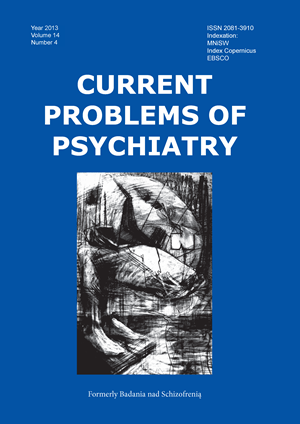Polska adaptacja i walidacja Skali Doświadczeń Maltretowanych Kobiet (Women's Experience With Battering Scale – WEB Scale)
Słowa kluczowe:
Skala WEB, przemoc ze strony partnera, polska adaptacjaAbstrakt
Cel. Celem pracy była adaptacja do warunków polskich oraz ocena własności psychometrycznych Skali Doświadczeń Maltretowanych Kobiet (WEB), mierzącej przemoc psychiczną, poczucie zagrożenia przemocą fizyczną lub psychiczną, poczucie utraty kontroli i władzy w związku, poczucie upokorzenia, izolacji, bezsilności.
Metoda. W ramach procedur adaptacyjnych przeprowadzono ocenę:
1) wierności tłumaczenia poprzez procedurę translacji-retranslacji oraz stopnia zrozumiałości słów i zdań,
2) równoważności fasadowej, rozumianej jako forma graficzna testu, liczba i kolejność pytań, format pytań, liczba i sformułowanie kategorii odpowiedzi, instrukcje i przykłady, obliczanie wyników,
3) równoważności psychometrycznej poprzez ocenę rzetelności rozumianej jako stabilność testu i zgodność wewnętrzna.
Materiał. Badania z zastosowaniem polskiej wersji Skali WEB przeprowadzono na grupie 200 pacjentek podstawowej opieki zdrowotnej (średnia wieku 43,34 lata, SD = 12,08, przedział wieku od 19 do 78 lat) w sześciu ośrodkach Podstawowej Opieki Zdrowotnej na terenie województwa lubelskiego w powiatach biłgorajskim i janowskim.
Wyniki. Wynik wskazujący na doznawanie przemocy lub zagrożenie przemocą uzyskały 102 przebadane pacjentki (51%). Polska wersja Skali WEB okazała się narzędziem o dużej zgodności wewnętrznej (α Cronbacha = 0,98), zadawalającej stabilności czasowej (wsp. r-Pearsona = 0,988) oraz o krótkim czasie wykonania (<10 minut).
Wnioski. Na podstawie przedstawionych wyników procedur adaptacyjnych i walidacyjnych można uznać polską wersję Skali WEB za narzędzie o zadowalających własnościach psychometrycznych, pozwalających na stosowanie tej przesiewowej skali zarówno w codziennej praktyce lekarskiej, jak i w badaniach dotyczących przemocy wobec kobiet ze strony partnera.
Bibliografia
1. Rada Europy http://www.coe.int/t/dg2/equality/domesticviolencecampaign/Fact_Sheet_en.asp stan z dnia 10.01.2014 za Amnesty International http://amnesty.org.pl/uploads/media/Przemoc_wobec_kobiet_FIN.pdf
2. Gruszczyńska B. Przemoc wobec kobiet w Polsce: aspekty prawnokryminologiczne. Warszawa: Wolters Kluwer Polska; 2007.
3. http://statystyka.policja.pl/st/informacje/91165,Przeciwko-przemocy-domowej-dane-za-polrocze-2013.html stan z dnia 10.01.2014
4. Campbell J., Snow Jones A. Dienemann J., Kub J., Schollenberger J., O'Campo P., Carlson Gielen A., Wynne C. Intimate partner violence and physical health consequences. Arch. Intern. Med., 2002; 162(10): 1157–1163.
5. Dąbkowska M. Ocena wybranych funkcji poznawczych u ofiar przemocy domowej. Psychiatr. Pol., 2007; 41(6): 837–849.
6. Dąbkowska M. Ocena zależności między czynnikami emocjonalnymi i poznawczymi aleksytymii a nasileniem PTSD u ofiar przemocy domowej. Psychiatr. Pol., 2007; 41(6): 851–862.
7. Dillon G., Hussain R., Loxton D., Rahman S. Mental and physical health and intimate partner violence against women: a review of the literature. Int. J. Fam. Med., 2013; Article ID 313909.
8. Salber PR., Taliafero E. O przemocy domowej. Poradnik dla lekarza pierwszego kontaktu. Warszawa: PARPA; 1998.
9. Smith P.H., Earp JA., DeVellis R. Measuring battering: development of the Women's Experience with Battering (WEB) Scale. Womens Health, 1995; 1(4): 273–288.
10. Smith PH., Tessaro I., Earp JA. Women's experience with battering: a conceptualization from qualitative research. Womens Health Issues, 1995; 5: 197–182.
11. Coker AL., Flerx VC., Smith PH., Whitaker DJ., Fadden MK., Williams M. Partner violence screening in rural health care clinics. Am. J. Public Health, 2007; 97(7): 1319–1325.
12. Bonomi AE., Anderson ML., Reid RJ., Rivara FP., Carrell D., Thompson RS. Medical and psychosocial diagnoses in women with a history of intimate partner violence. Arch. Intern. Med. 2009; 169(18): 1692–1697.
13. Thompson RS., Bonomi AE., Anderson M., Reid RJ., Dimer JA., Carrell D., Rivara FP. Intimate partner violence prevalence, types, and chronicity in adult women. Am. J. Prev. Med. 2006; 30(6): 447–457.
14. Coker AL., Pope BO., Smith PH., Hussey JR. Assessment of clinical partner violence screening tools. J. Am. Med. Womens Assoc., 2001; 56(1): 19–23.
15. Coker AL., Smith PH., McKeown RE., King MJ. Frequency and correlates of intimate partner violence by type: physical, sexual, and psychological battering. Am. J. Public Health, 2000; 90(4): 553–559.
16. Brzeziński J. Metodologia badań psychologicznych. Warszawa: Wydawnictwo Naukowe PWN; 2004.
17. Drwal RŁ. Adaptacja kwestionariuszy osobowości: wybrane zagadnienia i techniki; pod red. Piotra Brzozowskiego przy współpr. Piotra Olesia. Warszawa: Wydawnictwo Naukowe PWN; 1995.
18. Stanisz A. Analiza korelacji. Podstawy statystyki dla prowadzących badania naukowe. Med. Praktyczna, 2000; 10: 176–181.


